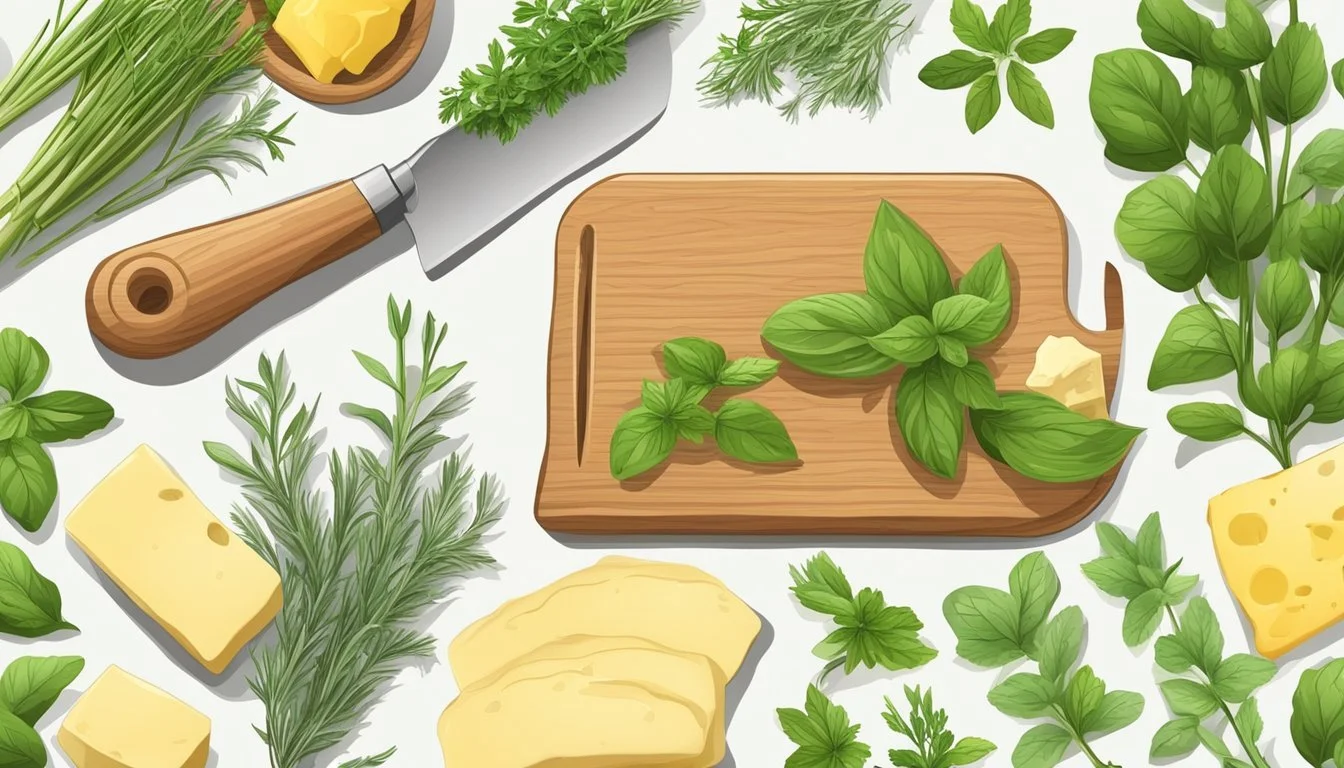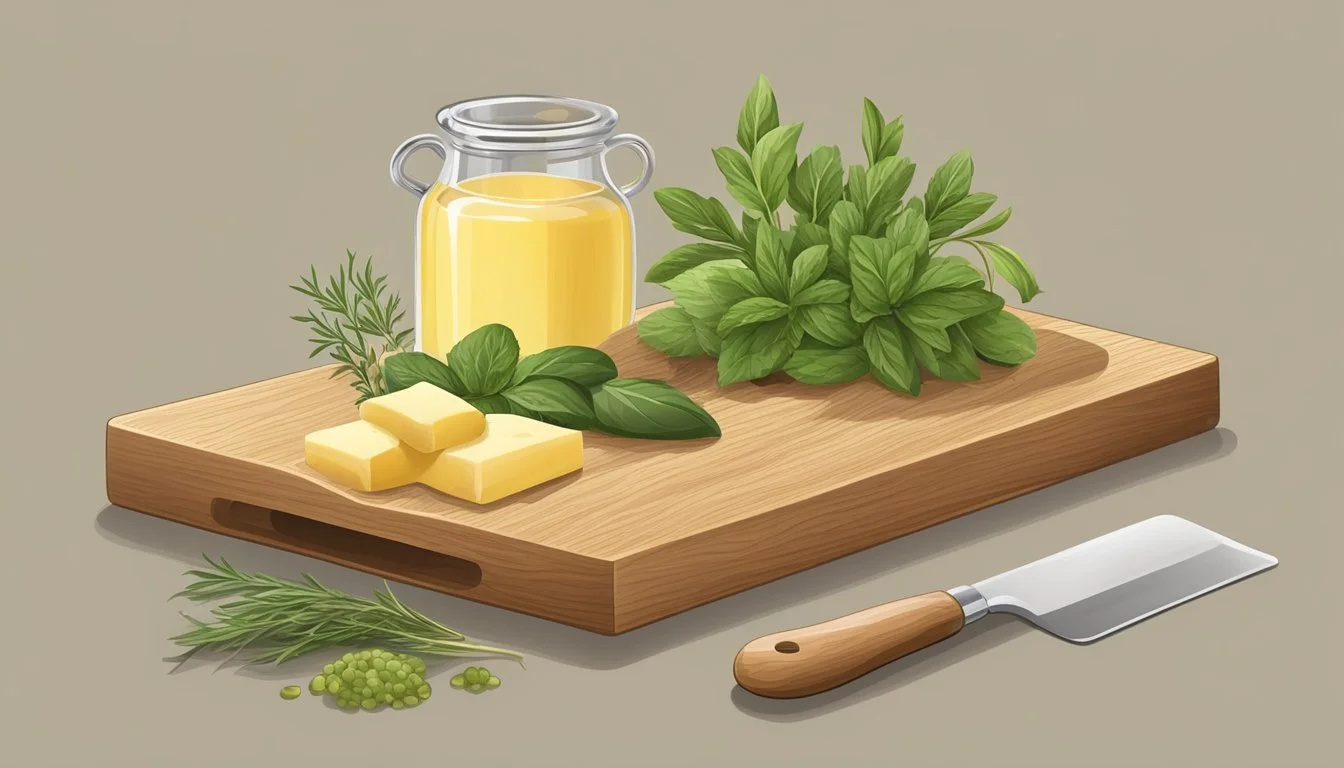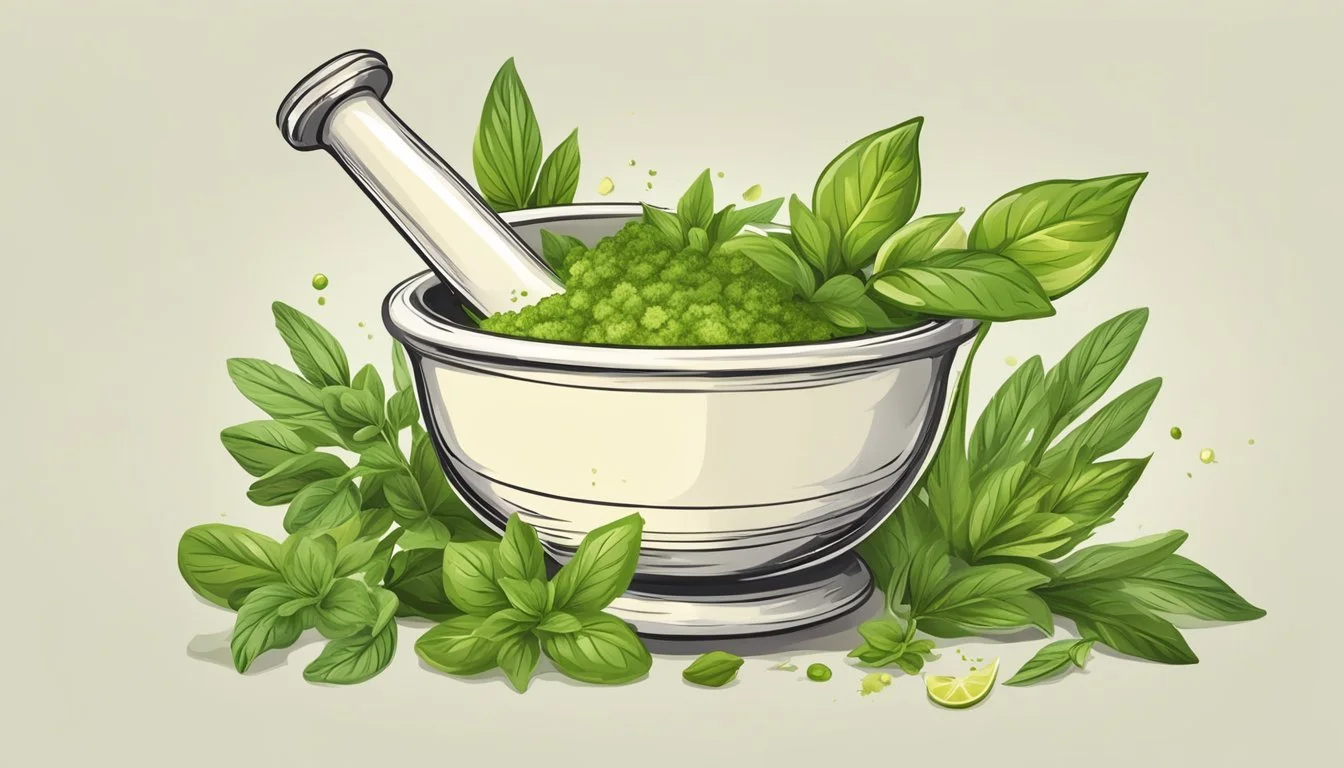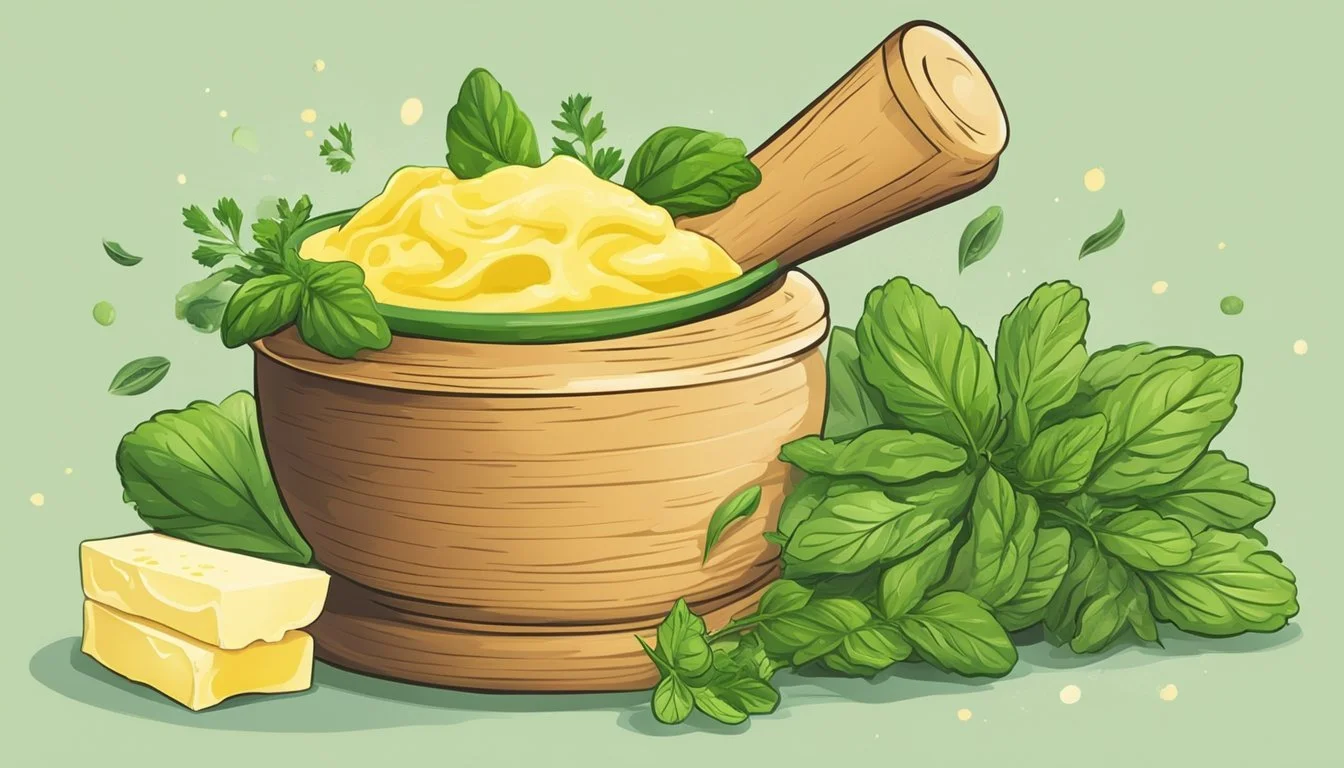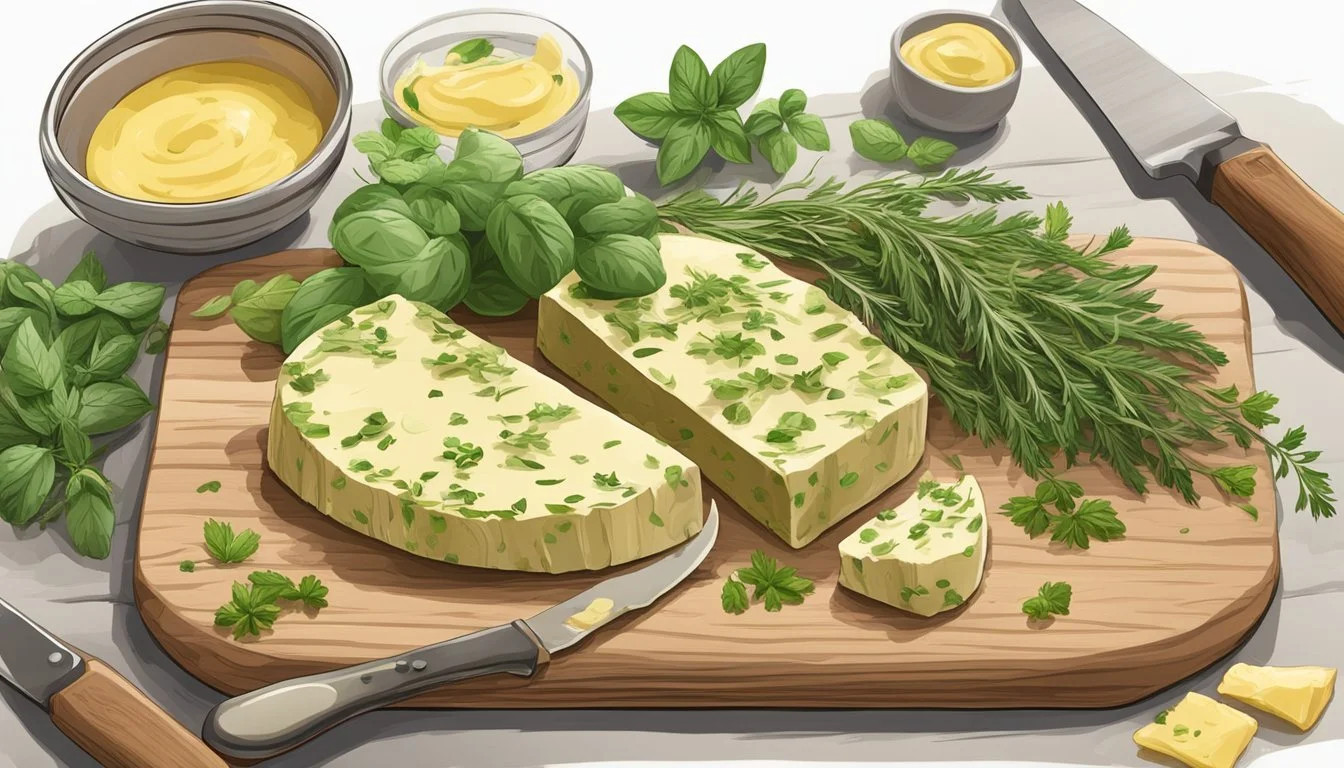Herb Stem Butter
A Flavorful Twist on Compound Butter with Zero Waste
Compound butter, a culinary staple, is a versatile enhancement that brings a depth of flavor to a range of dishes, from the simplest vegetables to the most exquisite steaks. Traditional compound butter blends softened butter with a combination of finely chopped herbs, spices, or other flavorings. The ease of preparing compound butter at home allows for customization and creativity, offering a tangible way to elevate home cooking with gourmet flair.
The innovation in the kitchen knows no bounds, and this is evident in the growing trend of herb stem butter. Typically, herb leaves receive the spotlight for their aromatic contribution to dishes, but the stems, often discarded, hold robust flavors of their own. By incorporating finely chopped herb stems into compound butter, not only is kitchen waste reduced, but a new dimension of taste is unlocked. The fibrous texture of the stems is softened when blended with the creamy richness of butter, resulting in a uniquely textured, flavorful spread.
By using herb stem butter, cooks bring out unexpected notes in their culinary creations, demonstrating that even the most overlooked kitchen scraps have potential. Whether slathered over warm bread, melted onto grilled vegetables, or used to finish off a pan-seared fillet, herb stem compound butter imparts a delightful burst of flavor that complements and elevates a medley of dishes, making it a must-try for any culinary enthusiast.
Understanding Compound Butter
The varied flavors and elevated quality of meals are often attributed to the use of compound butters. This versatile concoction combines butter with an assortment of ingredients, resulting in an enhanced, flavorful addition to dishes.
Defining Compound Butter
Compound butter, known for its flavor-enhancing qualities, is simply butter that has been mixed with supplementary flavoring agents such as herbs, spices, garlic, or shallots. The primary goal is to infuse the butter with a range of flavors that can complement and enrich various recipes, from meats to vegetables to breads. They can be formed into rolls, chilled, and sliced for convenience, or stored in containers for spooning out as needed.
History and Popularity
The popularity of compound butter can be traced back to the days of ancient Rome and France, where mixing butter with different herbs and spices was commonplace to create intricate flavors. Their simplicity and the sophistication of flavors they bring to the table have cemented their reputation in the culinary world. Chefs and home cooks alike treasure compound butter for its ability to elevate the taste and quality of an ordinary meal with minimal effort.
Essential Ingredients
Creating a herb stem butter involves a careful selection of foundational ingredients that will blend to enrich flavors in various dishes. The quality of these ingredients directly influences the final taste and fragrance of the compound butter.
Choosing the Right Butter
The base of any compound butter is good-quality butter. It is recommended to choose unsalted butter for its purity and ability to let the flavors of the herbs shine through. For those preferring a predefined salt level, salted butter can be an alternative, though this limits control over the seasoning. Butter should be softened to room temperature to easily incorporate other elements.
Selecting Fresh Herbs
The hallmark of compound butter is the fresh herbs, which must be finely chopped to release their essential oils. Popular options include parsley, basil, chives, and thyme — each contributing a unique flavor profile. Stems from these herbs are often discarded, but they can be used here as they're full of flavor. When selecting herbs, they should be fresh and vibrant in color, signifying their potency.
Incorporating Additional Flavors
To enhance the herbaceous character of the butter, a variety of additional flavors can be included:
Garlic: Typically, one or two garlic cloves, minced, provide a robust undertone.
Citrus: A zest of lemon can introduce a refreshing twist.
Seasonings: Sea salt and cracked black pepper are essential for a balanced taste.
Optional Enhancers: For a sweet and savory note, a bit of honey can be mixed in. Olive oil can be drizzled in to make the butter more spreadable.
These ingredients are stirred into the softened butter until the mixture is uniform. The combination can vary according to taste preferences and should complement the dishes it will accompany.
Preparation Techniques
Creating a flavorful herb stem compound butter involves a few precise techniques, starting with a well-combined herb mixture, shaping the butter into a convenient log, and storing it to preserve its freshness and flavors.
Making the Herb Mixture
To ensure an even distribution of flavors throughout the compound butter, one should start with softened butter, brought to room temperature. A hand mixer or a rubber spatula can be used to thoroughly mix finely chopped herb stems with the softened butter. It is essential that the herb stems are fresh and finely minced for maximum flavor infusion.
Forming the Butter Log
Once the herb mixture is ready, the next step is to shape it for convenient use. Lay a piece of wax paper, parchment paper, or plastic wrap flat on the surface. Transfer the herb butter mixture onto the paper and gently shape it into a log. By rolling the log tightly and twisting the ends, the butter will hold its shape when chilled.
Storing for Later Use
Compound butter can be stored in the refrigerator or freezer. For short-term use, wrap the log in wax paper and place it in the refrigerator to chill. To store the butter for an extended period, wrap it in parchment paper and then enclose it in a freezer-safe bag or airtight container. It can be frozen for several months, allowing the flavors to meld together. When ready to use, one can slice off just the needed amount, ensuring the rest remains fresh.
Culinary Applications
Herb stem butter elevates a variety of dishes with its robust flavor. It serves as both an enhancement and a key ingredient providing a depth of flavor to breads, proteins, and vegetables.
Serving Suggestions with Bread
Bread: A generous slathering of garlic herb butter transforms ordinary toast or dinner (What wine goes well with dinner?) rolls into a delectable treat. For garlic bread, one can spread the herb butter on a baguette and broil it until golden.
Toast: Apply garlic herb butter on toast for an aromatic breakfast option.
Dinner Rolls: Infuse dinner rolls with garlic herb butter to make them a hit at any gathering.
Enhancing Meat and Protein Dishes
Meat and Protein: When applied to steak or chicken, the herb stem butter introduces a burst of flavor that complements the natural taste of the meat.
Steak: Top a grilled steak with a pat of garlic herb butter to melt over the meat, creating a rich, savory sauce.
Chicken: Prior to roasting chicken, stuff garlic herb butter under the skin to ensure moist, flavored meat.
Vegetable and Side Dish Pairings
Vegetables and Sides: Potatoes, when mashed with herb stem butter, elevate this traditional side dish with a touch of elegance.
Mashed Potatoes: Incorporate garlic herb butter into mashed potatoes for an aromatic twist.
Vegetables: Sauté vegetables in garlic herb butter to complement their natural flavors.
Fish: Brush fish fillets with herb butter before baking to add a subtle yet distinct flavor.
Flavor Variations and Combinations
Creating a palatable herb stem butter involves mixing various herbs and seasonings to strike a balance between savory undertones and aromatic highlights. This section explores different flavor combinations and innovative mix-ins for crafting compound butter that complements any dish.
Classic Herbs and Seasonings
Fresh Herbs: Incorporate finely chopped fresh parsley, dill, rosemary, oregano, sage, and thyme to imbue butter with traditional flavors.
Citrus Zest: Grated lemon zest can add a refreshing twist, particularly when combined with dill or tarragon for fish dishes.
Dried Herbs: When fresh herbs are not available, dried herbs can be a potent substitute, though they should be used in smaller quantities due to their concentrated flavor.
Herb Pairing Suggestion Notes Fresh Parsley Garlic, lemon zest Ideal for poultry and potatoes. Rosemary Kosher salt, garlic Excellent for red meats. Sage Black pepper, kosher salt Complements pork and root vegetables.
Innovative Mix-Ins and Twists
Culinary Innovation: For a gourmet touch, incorporate basil pesto, or experiment with cilantro for a Mexican flair.
Garlic Herb Compound Butter: Garlic pairs well with almost any herb, especially rosemary and thyme, creating a classic garlic herb compound butter.
Bold Mix-Ins: Consider adding softened caramelized onions, roasted garlic, or finely chopped sun-dried tomatoes to the herb butter for more depth.
Mix-Ins Recommended Herb Pairing Dish Pairing Basil Pesto Oregano, pine nuts Perfect for Italian dishes. Cilantro Lime zest, chili flakes Great for grilled corn or tacos. Caramelized Onion Sage, thyme Ideal for steak or baked bread.
Note: Balancing the proportions of mix-ins with the base butter is crucial to avoid overpowering the subtle flavors of the herbs.
Health and Nutrition Considerations
When considering incorporating herb stem butter into a diet, one must remain aware of both its nutritional implications, particularly regarding caloric and fat content, and the health benefits conferred by the inclusion of fresh herbs.
Caloric and Fat Content
Herb stem butter, like all compound butters, is primarily composed of butter, which is a calorie-dense food with a high fat content. A single tablespoon typically contains about 100 calories and 11 grams of fat, which can quickly add up if used in large quantities. The types of butter used—whether salted or unsalted—do not significantly differ in caloric content. However, unsalted butter is often recommended for those monitoring their sodium intake.
Benefits of Using Fresh Herbs
Fresh herbs used in herb stem butter, such as parsley, cilantro, and basil, contribute minimal calories and provide a wealth of nutritional benefits. These herbs are rich in vitamins, minerals, and antioxidants, offering an array of health benefits including anti-inflammatory properties and immune support. Fresh herbs can also aid in digestion and provide flavor enhancement without the need for excess salt, supporting those who aim for a heart-healthy diet. Including the stems of fresh herbs maximizes the use of the plant and ensures less waste without compromising the nutritional value.
Tips and Tricks for Perfect Herb Butter
Creating the ideal herb butter is straightforward, and ensuring it has a robust flavor and versatile application only requires a few careful considerations. The reader will learn how to achieve the right texture, maximize flavor, and make the most of herb butter in various presentations.
Achieving Ideal Texture
For the perfect texture, one should start with butter that's softened to room temperature. This makes it easier to blend in the additional ingredients without overworking the butter, which can make it too soft. The goal is a compound butter that's spreadable yet firm enough to hold its shape. Once mixed, one can shape the butter into a log using parchment paper and refrigerate it until it's firm.
Maximizing Flavor and Freshness
To ensure a compound butter is delicious and full of bold flavor, using fresh herbs is paramount. One should finely chop these herbs to release their natural oils. Incorporating leftover herbs into the butter not only reduces waste but also adds an intense layer of flavor. For an aromatic kick, incorporating freshly ground black pepper enhances the butter's taste profile. It's best to store the butter in the refrigerator, which can help preserve its freshness for 2-3 weeks.
Creative Uses and Presentation
Herb butter is exceptionally versatile; it can be used to elevate numerous dishes from grilled meats to fresh bread. For a creative presentation, one can form the butter into shapes using molds or even pipe it for decorative purposes. To serve, simply slice or spoon the desired amount and let it complement the warm dish for an instant melt of delicious flavors.
Storing and Shelf Life
Proper storage is crucial for maintaining the freshness and flavor of herb stem butter. The shelf life of herb stem butter varies significantly depending on the storage method.
Short-Term Refrigeration
Herb stem butter can be refrigerated for immediate or short-term use. For optimal freshness, one should place the butter in the refrigerator within:
1-2 hours of preparation to allow the flavors to meld.
It remains fresh for 2-3 weeks when properly stored in airtight containers or wrapped in parchment paper.
Fridge Temperature Range: Ideally, between 32°F (0°C) and 40°F (4°C).
Long-Term Freezing Options
For extending the shelf life of herb stem butter, freezing provides a viable long-term solution:
An airtight container or wrap prevents freezer burn and flavor loss.
Shelf life in the freezer extends to 2-6 months, depending on the herb types used (dried herbs may last longer than fresh ones).
Freezer Storage Tip: Label with the date to keep track of freshness.
Maintaining Quality Over Time
To ensure food safety and quality, frequent temperature checks are recommended:
Avoid storing near the fridge door to prevent temperature fluctuations.
Regular Checks: Monthly inspections minimize the risk of spoilage.
Quality Indicator: Herb stem butter should retain its original color and aroma. Any discoloration or off-smells indicate spoilage and the butter should be discarded.
Serving Occasions
Herb stem butter, with its rich flavor profile, can elevate simple dishes into gourmet experiences. Its versatility makes it suitable for various dining settings, from laid-back family gatherings to the elegance of formal dinners.
Casual Family Meals
Herb stem butter is an excellent addition to casual family meals, where comfort meets taste. It can transform baked potatoes with its creamy herb-infused richness or be drizzled as a sauce over corn on the cob for a summer treat. For a simple, yet delicious appetizer, family members can spread homemade herb butter on a warm dinner roll or cornbread, infusing the meal with an aromatic depth.
Formal Dinner Parties
At formal dinner parties, herb stem butter serves as a sophisticated touch that can impress guests. It can be offered as an alternative to traditional sauces, providing a subtle herbaceous note to steaks or seafood. For a side that's both flavorful and elegant, hosts can incorporate it into dishes with new potatoes or seasonally available vegetables, demonstrating both culinary expertise and attention to detail.
Seasonal and Holiday Uses
During holidays and special occasions, herb stem butter captures the essence of the seasons. Utilize summer herbs like basil and parsley to complement light, festive fare. In the colder months, richer herbs such as rosemary and thyme pair well with hearty meals. When crafting sauce alternatives for holiday dinners, one may consider enhancing the butter with maple syrup for a hint of sweetness that goes well with autumnal and winter dishes. Herb stem butter can also be formed into decorative shapes to adorn a holiday table, making it as much a centerpiece as it is a condiment.
Recipe Compilation
Herb stem butter elevates simple dishes by adding a burst of flavor. This section provides a step-by-step guide to crafting your own and explores a variety of recipes to which you can apply this aromatic condiment.
Step-By-Step Instructions
Select Herbs: Choose fresh herbs such as rosemary, thyme, or parsley. Do not discard the stems, as they contain flavor too.
Prepare the Butter: Let the butter soften at room temperature until it's malleable.
Finely Chop: Mince the herbs and stems finely; the smaller, the better for even distribution.
Mix: Combine herbs with the softened butter. Integrate ingredients until herbs appear evenly distributed throughout the butter.
Shape and Chill: Transfer the butter onto parchment paper or plastic wrap. Roll it into a log approximately 4 inches long. Chill until firm, typically about 2 hours.
Variety of Herb Butter Recipes
Homemade Garlic Bread:
Use the herb butter as a spread on a sliced baguette. Broil until golden brown.
Creamy Mashed Potatoes:
Stir herb butter into the potatoes for a rich, aromatic flavor.
Roasted Turkey:
Under the skin or on top of the turkey, the herbed butter adds moisture and depth.
A dollop of herb butter on baked sweet potatoes brings out their natural sweetness.
Salmon:
Brushing salmon with herb butter before baking creates a succulent, flavorful crust.
Steaks (such as Filet Mignon):
Top a seared steak with a slice of herb stem butter for a luxurious finish.
Table of Recommend Herb Pairings:
Herb Pairs well with Rosemary Roasted turkey, steak Thyme Chicken, potatoes Parsley Seafood, garlic bread Sage Pork, sweet potatoes
Garlic cloves can be finely minced and added to the herb butter for a more robust flavor, complementing dishes like garlic bread and mashed potatoes. Each recipe can be adorned with a generous serving of this homemade compound butter to enhance its taste and present a gourmet experience.

